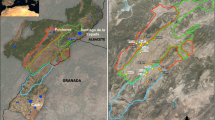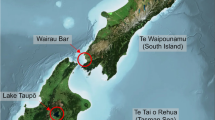Abstract
Conservation projects in developing countries that depend on international donors or international capacity building partnerships often have to bridge a gap between donors’ or experts’ ideas of best practice and local ideas of best practice. We examine how this gap may be successfully bridged by examining the case of the Wangchuck Centennial National Park (WCNP) in Bhutan. This protected area was attracting considerable outside investment but presented an unusual situation in 2013: it was largely viewed positively by local communities living in the park, even though, five years after it was gazetted, it had no clear boundaries, and its management was identical to management outside the park. Why did the WCNP have this form, and why was it viewed favorably by local people? Our interviews and survey reveal that this may be due to practical and favourable integrated conservation and development projects implemented by the park management, more people-friendly rules adopted by the Bhutanese government, and a cultural ethos of sustainable development and environmentalist Buddhist sentiments. Applying the tacit working models of conservation framework, we argue that although the protected area as a form of conservation normally is designed to fit the ‘uniformity model’ of a bounded area with specific rules and management, the WCNP has been culturally re-designed to fit the more culturally suitable ‘normative model’ that is territorially extensive and values-based. We suggest that this adaptation of global conservation concepts to local cultural perspectives may be a factor in Bhutanese conservation success.



Similar content being viewed by others
Data availability
Data will be made available upon publication on ResearchGate.
References
Allison E (2017) Spirits and nature: the intertwining of Sacred Cosmologies and Environmental Conservation in Bhutan. J Study Rel Nat & Cult 11(2):197–226
Andam KS, Ferraro PJ, Pfaff A, Sanchez-Azofeifa GA, Robalino JA (2008) Measuring the effectiveness of protected area networks in reducing deforestation. PNAS 105(42):16089–16094
Anonymous no date. WCNP fact sheet. Obtained from WCNP staff, not available online
Atela JO, Quinn CH, Minang PA, Duguma LA (2015) Implementing REDD + in view of integrated conservation and development projects: leveraging empirical lessons. Land Use Pol 48:329–340
Brandon KE, Wells M (1992) Planning for people and parks: design dilemmas. World dev 20(4):557–570
Bruggeman D, Meyfroidt P, Lambin EF (2018) Impact of land-use zoning for forest protection and production on forest cover changes in Bhutan. Appl Geogr 96153-96165. https://doi.org/10.1016/j.apgeog.2018.04.011
Bruner AG, Gullison RE, Rice RE, Da Fonseca GA (2001) Effectiveness of parks in protecting tropical biodiversity. Science 291:125–128
Butler JRA, Young JC, McMyn IAG, Leyshon B, Graham IM, Walker I et al (2015) Evaluating adaptive co-management as conservation conflict resolution: learning from seals and salmon. J Environ Manage 160:212–225
Delay E, Ka A, Niang K, Touré I, Goffner D (2022) Coming back to a Commons approach to construct the Great Green Wall in Senegal. Land Use Pol 115:106000
Dendup N (2011) Socio-economic report, Wangchuck Centennial Park. Department of Forests and Park Services, Government of Bhutan
Dorji T, Linke S, Sheldon F (2019) Half century of protected area dynamism in the country of Gross National Happiness, Bhutan. Cons Sci Practice 1(7):e46
Dudley N (ed) (2008) Guidelines for applying protected area management categories. IUCN, Gland
Galvin K, Beeton T, Luizza M (2018) African community- based conservation: a systematic review of social and ecological outcomes. Ecol Soc 23:588–597
Geldmann J, Coad L, Barnes M, Craigie ID, Hockings M, Knights K et al (2015) Changes in protected area management effectiveness over time: a global analysis. Biol Cons 191:692–699
Goulden S, Erell E, Garb Y, Pearlmutter D (2017) Green building standards as socio-technical actors in municipal environmental policy. Building Res & Info 45(4):414–425
Gurney GG, Cinner J, Ban NC, Pressey RL, Pollnac R, Campbell SJ et al (2014) Poverty and protected areas: an evaluation of a marine integrated conservation and development project in Indonesia. Global Environ Change 26:98–107
Hayes TM (2006) Parks, people, and forest protection: an institutional assessment of the effectiveness of protected areas. World Dev 34:2064–2075
Horwich RH, Lyon J (2007) Community conservation: practitioners’ answer to critics. Oryx 41(3):376–385
ICCA Handbook, version 1.2. 2003. UNEP. Retrieved 2021 from: https://wedocs.unep.org/bitstream/handle/20.500.11822/8448/-A%20handbook%20for%20the%20indigenous%20and%20community%20conserved%20areas%20registry-2010ICCA_Handbook.pdf?sequence=3&%3BisAllowed=
Jacobson C, Robertson AL (2012) Landscape conservation cooperatives: bridging entities to facilitate adaptive co-governance of social–ecological systems. Hum Dim Wildl 17(5):333–343
Katel ON, Schmidt-Vogt D (2011) Use of Forest Resources by residents of Jigme Singye Wangchuck National Park, Bhutan. Mountain Res Dev 31(4):325–333
Land Act of Bhutan (2007)Royal Government of Bhutan
Lham D, Wangchuk S, Stolton S, Dudley N (2019) Assessing the effectiveness of a protected area network: a case study of Bhutan. Oryx 53(1):63–70
Li BV, Kim MJ, Xu W, Jiang S, Yu L (2021) Increasing livestock grazing, the unintended consequence of community development funding on giant panda habitat. Biol Cons 257:109074
Martin A, Rutagarama E, Gray M, Asuma S, Bana M, Basabose A, Mwine M (2011) Linking Development Interventions to Conservation: perspectives from partners in the International Gorilla Conservation Programme. Soc Nat Res 24(6):626–636
Ojha AP, Sarker TK (2012) Effectiveness of the integrated conservation and development program (ICDP) in conserving wildlife in the Annapurna Conservation Area in Nepal. Int J Biodiv Cons 4(6):237–242
Penjor U, Wangdi S, Tandin T, Macdonald DW (2021) Vulnerability of mammal communities to the combined impacts of anthropic land-use and climate change in the himalayan conservation landscape of Bhutan. Ecol Indic 121:107085
Rodríguez-Rodríguez D, Martínez-Vega J, Echavarría P (2019) A twenty year GIS-based assessment of environmental sustainability of land use changes in and around protected areas of a fast developing country: Spain. Int J App Earth Obs Geoinfo 74:169–179
Root-Bernstein M (2020) Tacit working models of human behavioural change I: Implementation of conservation projects. Ambio 49(10):1639–1657. https://doi.org/10.1007/s13280-019-01298-4
Root-Bernstein M, Bondoux A, Guerrero-Gatica M, & Zorondo-Rodriguez F (2020) Tacit working models of human behavioural change II: Farmers’ folk theories of conservation programme design. Ambio 49(10):1658–1675
Ruiz-Mallén I, Schunko C, Corbera E, Rös M, Reyes-García V (2015) Meanings, drivers, and motivations for community-based conservation in Latin America. Ecol Soc 20:393–406
Salafsky N, Margoluis R (2004) Using adaptive management to improve ICDPs. In: McShane T, Wells M (eds) Getting biodiversity projects to work: towards more effective conservation and development. Columbia University Press, New York, pp 372–394
Siebert SF, Belsky JM (2014) Historic livelihoods and land uses as ecological disturbances and their role in enhancing biodiversity: an example from Bhutan. Biol Cons 177:82–89
Temenos C, McCann E (2013) Geographies of policy mobilities. Geo Compass 7(5):344–357
Uchida E, Rozelle S, Xu J (2009) Conservation payments, liquidity constraints, and off-farm labor: impact of the grain‐for‐Green Program on rural households in China. Am J Ag Econ 91(1):70–86
Wang SW, Lassoie JP, Curtis PD (2006) Farmer attitudes towards conservation in Jigme Singye Wangchuck National Park, Bhutan. Env Cons 33(2):148–156
Wang SW, Macdonald DW (2006) Livestock predation by carnivores in Jigme Singye Wangchuck National Park, Bhutan. Biol Cons 129(4):558–565
Wangchuck Centennial National Park management plan
Wangchuck Centennial National Park. No date. Informational sheet. Obtained during fieldwork in 2013
Wangda P, Ohsawa M (2006) Gradational Forest Change along the Climatically Dry Valley Slopes of Bhutan in the midst of Humid Eastern Himalaya. Plant Ecol 186(1):109–128
Wells MP, McShane TO (2004) Integrating protected area management with local needs and aspirations. Ambio 33(8):513–519
Wells MP, McShane TO, Dublin HT, O’Connor S, Redford KH (2004) The future of Integrated Conservation and Development Projects: building on what works. Getting biodiversity projects to work. Columbia University Press, New York, pp 397–422
Acknowledgements
We are very grateful to the following people and institutions for permissions and support in carrying out this project: The Royal Government of Bhutan; Dr Nawang Norbu, Dr Tshering Tempa, Wangchuk Dorji and the staff at Ugyen Wangchuck Institute of Conservation and Environment Research, Bhutan; Dr D. S. Rai and staff at Wangchuck Centennial Park; Dr Sonam Wangyel Wang for sharing the initial questionnaire and for guidance on research design; Phurba Lhendup, WWF Bhutan; Dr Paul Jepson and Dr Shonil Bhagwat, School of Geography and the Environment, University of Oxford; Dr Uri Roll from Oxford University Centre for the Environment for advice on data analysis for an earlier version of the manuscript; Menlha Wangmo for cultural introductions. We are grateful to all our interviewees and survey respondents for their time. We gratefully acknowledge a bursary from the Mulder House trust fund, Linacre College, Oxford.
Funding
TN received a bursary from the Mulder House trust fund, Linacre College, Oxford.
Author information
Authors and Affiliations
Contributions
TN conceived of the project, collected and analyzed the data, and co-wrote the manuscript. SS provided guidance and support in the field. MR-B conceived and carried out the data analysis, and co-wrote the manuscript.
Corresponding author
Ethics declarations
Competing interests
The authors declare that they have no conflict of interest.
Additional information
Communicated by Peter Bridgewater.
Publisher’s Note
Springer Nature remains neutral with regard to jurisdictional claims in published maps and institutional affiliations.
Rights and permissions
Springer Nature or its licensor (e.g. a society or other partner) holds exclusive rights to this article under a publishing agreement with the author(s) or other rightsholder(s); author self-archiving of the accepted manuscript version of this article is solely governed by the terms of such publishing agreement and applicable law.
About this article
Cite this article
Narayan, T., Sherub, S. & Root-Bernstein, M. A culturally appropriate redesign of the roles of protected areas and community conservation: understanding the features of the Wangchuck Centennial National Park, Bhutan. Biodivers Conserv 32, 609–634 (2023). https://doi.org/10.1007/s10531-022-02515-5
Received:
Revised:
Accepted:
Published:
Issue Date:
DOI: https://doi.org/10.1007/s10531-022-02515-5




